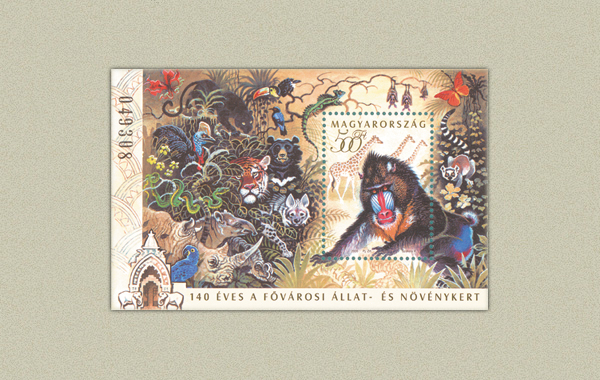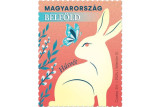
1. MAGYAR - 140 ÉVES A FŐVÁROSI ÁLLATKERT ÉS NÖVÉNYKERT - Bélyeg rendelési kód: 2006 év bélyegei kompletten
2. ENGLISH - BUDAPEST ZOO AND BOTANICAL GARDEN IS 140 YEARS OLD - Order code of the stamp: 2006 Year stamps complete
3. GERMAN - 140 Jahre im Budapester Zoo und Botanischer Garten - Marke die sprechstunde kode: 2006 Jahr Briefmarken komplett
1. MAGYAR - 140 ÉVES A FŐVÁROSI ÁLLATKERT ÉS NÖVÉNYKERT
A Magyar Posta alkalmi bélyegblokk kibocsátásával köszönti a 140 éves Fővárosi Állat- és Növénykertet.
Az első állattartó kerteket az ókori keleten hozták létre. Napjainkban a Bécs melletti Schönbrunn állatkertjét tartják a világ első újkori állatkertjének, amely 1752-ben nyitotta meg kapuit. Magyarország első állatkertje – az újkori állatkertek közül harmincadikként – 1866. augusztus 9-én nyílt meg. Parkrészeit Petz Ármin, a város főkertésze, a Nagy-tavat, és az azt tápláló kutat Reitter Ferenc csatornázási mérnök alakította ki. Az épületeket ifj. Koch Henrik és Szkalnitzky Antal tervezte. A közönség ekkor közel félszáz különféle állatot láthatott tizenegy nagyobb és számos kisebb állatházban, valamint elkerített, nyílt gyeptereken.
Az 1900-as évek elején az állatkert a fővároshoz került és átépítés kezdődött. A tervek alapján a rendszertani alapú bemutatást tűzték ki célul, azaz rokonság szerint csoportosítva mutatták be az állatokat. Ezzel párhuzamosan növénykertet is
terveztek. A régi állatkert szinte valamennyi épülete helyett újat emeltek. A Főkapu és az Elefántház Neuschlosz Kornél tervei alapján épült. Kós Károly és Zrumeczky Dezső tervezte a legtöbb állatházat, a Madárházat, a Bölényházat és a Szarvasházat. Ekkor emelték a Pálmaházat és az alatta található Aquariumot, Räde Károly és Ilsemann Keresztély tervei alapján.
Az újjáépített állatkert 1912. május 20-án tárta ki kapuit a nagyközönség előtt. Nagy elismerést váltott ki az újszerű beosztás, a száraz árkos, műsziklás bemutatási rendszer, valamint az országban korábban nem létező édesvízi és tengeri Aquarium. A Kissziklában kialakított Barlang Mozit is hamar megkedvelték a látogatók. Az első világháború, az azt követő pénzügyi válság, majd a gazdasági világválság komoly nehézségeket hozott. A második világháború idején újból tragikussá vált a helyzet. Építőanyag-, takarmány- és munkaerőhiány állt elő.
A vasút közelsége miatt egy-mást érték a bombázások, leomlottak az épületek, elpusztultak az állatok. A háború utáni évekre az újjáépítés volt jellemző. 1966-ban, a kert megnyitásának centenáriumán alakították ki a Rovarházat, hozták rendbe a Kis- és a Nagysziklát. A háborúban elpusztult Zsiráfház helyére újat emeltek, és új Bölényház is épült. 1990-es évek közepétől megkezdődött a „rácsellenes" program, majd a tervszerű átalakítás. Úgyszólván az Állatkert minden pontján történt valami változás. Számos állatház újult meg, befejeződött a Pálmaház rendbehozatala, ismét régi szépségében tündököl az Elefánt-ház, és további létesítményeket is korszerűsítettek. A rekonstrukció során nemcsak az eredeti műemléki környezet megóvása, helyreállítása és gazdagítása volt a cél, hanem az állatok életkörülményeinek jobbá tétele is.
Az évfordulót köszöntő blokk bélyegképének főmotívuma a mandrill pávián, a háttérben zsiráfok láthatók. A blokk keretrajzán a Fővárosi Állat- és Növénykert féltett ritkaságai közül látható néhány, nevezetesen: jácintkék ara, széles szájú orrszarvú,
babírussza, tapír, csíkos hiéna, boa, szibériai tigris, örvösmedve, sisakos kazuár, feketepárduc, tündérkék irena, élescsőrű tukán, sisakos baziliszkusz, repülőkutyák, vörös tündérlepke, gyűrűsfarkú maki. A keretrajzon található jellegzetes növények:
kúszó liliom, aloe félék, broméliák, trópusi páfrányok, pálmák és liánok. Az alkalmi borítékon az állatkert látképe korhű ábrázolásmódban látható. Az alkalmi bélyegző grafikáját a selyemmajom és a pálmalevél stilizált rajza díszíti.
Megjelenési időpont: 2006. augusztus 9.
Forrás: Philatelia Hungarica Kft., Magyar Posta
2. ENGLISH - BUDAPEST ZOO AND BOTANICAL GARDEN IS 140 YEARS OLD
Magyar Posta is issuing a commemorative block to celebrate the 140 years of the Budapest Zoo and Botanical Garden.
The very first zoos were created in the East in ancient times, while the first garden where animals were kept that can be considered the first zoo of modern times was at Schönbrunn near Vienna, which opened in 1752. Hungary’s first zoo, the thirtieth in modern times, opened on 9 August 1866. Its park was designed by the municipal chief gardener Ármin Petz, and the Great Pond and the well supplying water to it was the work of the engineer Ferenc Reitter. The buildings were designed by Henrik Koch Jnr. and Antal Szkalnitzky. At the time the public could see almost fifty different types of animals in eleven houses of various sizes and enclosed outdoor grassed areas.
In the early 1900s the zoo came into municipal ownership and reconstruction began. The plan was to display the animals on a taxonomic basis, that is to say the animals were to be grouped according to relationships. At the same time plans for a botanic garden were also drawn up. New buildings were raised in place of almost all the old zoo’s structures. The main gate and the Elephant House were designed by Kornél Neuschlosz. Károly Kós and Dezső Zrumeczky designed most of the animal houses, the Bird House, the Buffalo House and the Deer House. The Palm House and Aquarium beneath it were built at this time based on plans by Károly Räde and Keresztély Ilsemann.
The rebuilt zoo opened its gates to the public on 20 May 1912. The new arrangement was highly acclaimed, as were the enclosures using a dry ditch and artificial cliffs, and the freshwater and sea Aquarium that had previously not existed in Hungary. The Cave Cinema in the Little Cliff soon became a favourite with the public. World War I, and the subsequent financial crisis and great depression brought grave difficulties, and the situation likewise became tragic during World War II with a lack of building materials, fodder and labour. Due to the proximity of the railway bombing destroyed buildings and killed animals. In the postwar years reconstruction took place.
In 1966 the Insect House was opened, and the Little and Large Cliffs were restored for the centenary of the zoo. A new Giraffe House was erected on the site of the one destroyed in the war and a new Buffalo House was completed. In the mid 1990s a project began to rid the zoo of bars and to systematically renovate the zoo. Thus every corner of the zoo has undergone change. Several animal houses have been restored to their former glory, such as the Palm and Elephant Houses, while others have been modernised. The reconstruction was aimed not only at preserving and enriching the zoo’s environment and buildings as historic monuments, but also at improving living conditions for animals.
The main motif of the stamp design of the block is a mandrill and there are giraffes in the background. The surrounding frame features some of the rarities that can be found in the Budapest Zoo and Botanical Garden. Of the animals there are the blue
macaw, white rhinoceros, babirusa, tapir, striped hyena, boa, Siberian tiger, Asiatic black bear, southern cassowary, black panther, fairy-bluebird, keel-billed toucan, green basilisk, fruit bats, ring-tailed lemur, and of the plants creeping lily, aloes, bromeliads, tropical ferns, palms and lianas. The first day cover shows a view of the zoo, while the design of the commemorative postmark incorporates a stylised marmoset and palm leaf.
Date of issue: 9 August 2006
3. GERMAN - 140 Jahre im Budapester Zoo und Botanischer Garten
Die Ungarische Post-hoc-Miniatur begrüßte die Freilassung von 140 Jahren der Budapester Zoo und Botanischer Garten.
Die ersten Halter des alten Gärten wurden im Osten geschaffen. Heute sind im Zoo Schönbrunn bei Wien die weltweit erste moderne Zoo, die im Jahre 1752 eröffnet. Ungarns erste Zoo - eine der modernsten Tiergärten harmincadikként - 1866. eröffnet am 9. August. Armin Parkrészeit Petz, Obergärtner der Stadt entwickelt, die Großen Seen, und die Brunnen Fütterung Reitter Ferenc Sanitation. Das Gebäude, Jr.. Koch, Henry und Anthony Szkalnitzky geplant. Das Publikum war so nahezu fünfzig verschiedene Tiere zu elf größere Anzahl von kleineren und Animal House zu sehen, und umzäunt, geöffnet gyeptereken.
Die 1900er waren der Anfang des Zoos in der Hauptstadt und begann den Wiederaufbau. Der Plan ist auf die taxonomische Präsentation soll zugrunde, nämlich die Verwandtschaft Gruppierungen wurden die Tiere vorgestellt. Zur gleichen Zeit zum Botanischen Garten
konzipiert. Der alte Zoo und nicht vielmehr ein neues Gebäude errichtet. Das Haupttor und dem Elefántház Neuschlosz Kornel gebaut nach den Plänen. Kos und Karl Zrumeczky Dezsö gestaltet die meisten der Animal House, das Vogelhaus, die Bölényházat und Szarvasházat. Sie haben das Palmenhaus und unter Aquariumot, Rade Ilsemann Christian Karl und Pläne.
Die wieder aufgebaute Zoo 1912th am 20. Mai, warf seine Türen für die Öffentlichkeit. Große Bewunderung von dem neuen Titel, die trockene ARKOS, műsziklás Präsentations-Systeme sowie das Land bisher nicht in Süß-und Meerwasser-Aquarium gibt. Die Höhle Kissziklában gegründet Kino bald für die Besucher beliebt. Der Erste Weltkrieg, die anschließende Finanzkrise und die wirtschaftliche Krise hat ernste Schwierigkeiten. Während des Zweiten Weltkrieges wieder tragikussá wurde die Situation. Baumaterialien, Futter, und in den Wehen lag.
Die Eisenbahnen sind aufgrund der Nähe eines mehr Wert-Bombardierung, Abbruch der Gebäude gefallen, starben die Tiere. In den Nachkriegsjahren wurden durch den Wiederaufbau geprägt. Im Jahr 1966 wurden die Hundertjahrfeier der Öffnung in den Garten Rovarházat bzw. kleine und Nagysziklát. Der Krieg zerstörte ein neues zu ersetzen Zsiráfház erhöht, und auch neu gebaut Bölényház. Mitte der 1990er Jahre begann die "rácsellenes Programm und die geplanten Umstellung. Fast jeder Punkt der Zoo eine Veränderung. Viele Animal House erneuert, die Vollendung des Palmenhaus in Ordnung ist, wieder leuchtet in der Schönheit der alten Elephant House und anderen Einrichtungen aktualisiert . Die Rekonstruktion der Original-Denkmal nicht nur die Umwelt zu schützen, Wiederherstellung und Verbesserung der Ziel war, sondern auch den Tieren bessere Lebensbedingungen zu machen.
Willkommen in der Jahrestag der Mandrill Pavian Block Vorschaubild főmotívuma sind Giraffen im Hintergrund angezeigt. Der Block ist der Rahmen des Budapester Zoo und Botanischer Garten sind einige der kostbaren Raritäten, und zwar: Hyazinth-Ara, ein weitmündigen Nashorn,
Echte Tapir, gestreiften Hyäne, boa, Sibirische Tiger, örvösmedve, Helmkasuar, feketepárduc, Mary Irena, élescsőrű Tukan, Basilisk Helme, Fledermäuse, rot tündérlepke, Ringtail lemur. Die typischen Pflanzen in den Rahmen:
Klettern Lilie, Aloe Schildkröten, Bromelien, tropische Farne, Palmen und Lianen. Der Umschlag der gelegentlichen Zoo ábrázolásmódban authentischen Blick auf das Display. Die gelegentliche Stempel der Grafik und den marmoset pálmalevél mit einem stilisierten Zeichnung verziert.


